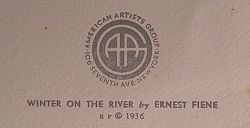| Fiene Quintanilla Online Catalogue Raisonné Project Home || About FQOCRP || Contact Us || Search the Site |
|
The Prints of Ernest Fiene:
A Catalogue Raisonné in progress by Jeffrey Coven (For Table of Contents, Click here, or scroll down this page.) |
|
|
|
|
To navigate this page, select from the links under any of the three menu headings below
by clicking its down arrow -- or simply scroll down the page. |
|
For those visitors to this catalogue who would prefer to familiarize themselves with its various features and methods of use before entering the catalogue, please read the material below. For those other visitors who would prefer to enter the catalogue immediately, please click the link in the menu at the left that best serves your needs. The same menu will appear on every page you visit, so if your first entry point is not exactly what you want, the other choices will remain before you. Features of this Catalogue Raisonné Thoroughness, accuracy, and facility of use are the objectives of this online catalogue raisonné. The first two of these elements have always been requirements for a good catalogue raisonné and without them it is impossible to claim the hallmark of authority so crucial to this type of reference work. The third, facility of use, is hopefully advanced beyond traditional limits through the features inherent in a catalogue raisonné published on the internet. Perhaps more than any other aspect of publication on the internet, the capacity to search for and find information stands out as primary. This reference work presents the researcher with several means of searching for information regarding the prints of Ernest Fiene:
The remainder of the "Using this Catalogue Raisonné" portion of the Introduction is, like the site itself, still in progress. Sections that are complete, partially complete or as yet without much or any content appear below. The primary repository for information on any given print in the catalogue is the full entry for that print. Each full entry contains (or will contain) all of the following standard elements of information: title, catalogue number, date, medium, edition, dimensions, printer, typical pencil annotations, public collections holding the print, and topic galleries including the print. Beyond these standard elements, each entry includes a photographic image of the print that can be enlarged and a notes section that supplements and/or clarifies the information in the standard elements. Each standard element is expanded upon below. (You may skip to the discussion of any particular element by clicking its name above.) Fiene was not uniform in his practice of giving titles to his prints. He often gave a title, in pencil, as part of the annotation of an edition (See examples of typical titles in pencil below.), but for most nudes, still lifes and portraits, he did not. For the purposes of this catalogue, if Fiene did not inscribe a title on the print in pencil, it is designated as "Untitled." A descriptive title in square brackets and italics follows, e.g. "Untitled [Nude Resting]." Exceptions are Associated American Artist (AAA) prints and his one American Artists Group (AAG) print, which carry the title on the label that accompanied each AAA impression, or, in the case of AAG, was usually printed on the reverse of the sheet as well as on an accompanying label. These are considered full-fledged titles by the Catalogue Raisonné. Catalogue entries for untitled prints included in the 1928 Downtown Gallery catalogue "Ernest Fiene New Lithographs" use the titles given there for a descriptive title. It is assumed that Fiene was aware of the titles used for his first exhibition devoted exclusively to his prints, and, perhaps, approved of them or even created them himself. The other descriptive titles have been created by us. When more than one print bears the same title, that title is followed by a number in square brackets to distinquish one from the other(s). For example, there are two lithographs bearing the title "Colonial Church." They appear in the catalogue as Colonial Church [1] and Colonial Church [2], where the numbers in square brackets are added by us not the artist. Below are examples of title forms accepted by the Catalogue Raisonné to establish titles for Fiene prints:
The numbering of the prints in this catalogue raisonné is generally based on chronological order. Several factors, however, have led to variations from a typical chronological numbering system: It is not known for certain what Fiene's first print was; nevertheless, the untitled monotype Bouquet in a Vase, dated 1919, has been assigned catalogue entry #1. No evidence exists for any other print created before 1922 or for any printmaking activity on Fiene's part before 1922. The liklihood, therefore, that "Bouquet in a Vase," is preceded by another print or prints is low, and hence the somewhat arbitrary assignment of catalogue entry # 1 justified. Uncertainty also veils the specifics about other early prints created before 1926. As a result catalogue entry numbers 2-13 are currently empty, awaiting the discovery of additional data for the prints thus far known only through references in auction records but as yet unexamined, or the discovery of early prints not yet known at all. (See chronological thumbnails page.) Catalogue entry #s 2-13 will be filled when images and enough data become available. It is certain, however, that the last prints Ernest Fiene made are the color lithographs printed in Paris in the summer of 1965. He died while working on them. Furthermore, it most likely that the very last print he made is Deep Winter [2], which has arbitrarily been given the catalogue number 100. (For further commentary on this, click here.) Should prints be discovered which need to be inserted between existing in-use numbers, they will be given alpha-numeric designations to maintain the chronological/numerical order, e.g. 27A. Any number currently assigned to a print will remain that print's catalogue raisonné number in perpetuity. Ordering within a given year is more or less arbitrary. This has become necessary because there is no comprehensive record of the order of creation of Fiene prints within any given year. (See "Dating" below.) Main Data Column
No significant record of dating other than the dates on the prints themselves is known, except in the case of Associated American Artists prints, the dates of publication for which were provided by the late Mr. Sylvan Cole, former director of AAA. Hence, there is currently no reliable way to establish chronology within a particular year. The order of presentation within a particular year is, therefore, arbitrary.
Apparently Fiene kept no comprehensive records of his printmaking activity. Neither did Fiene's chief printer for lithographs, George C. Miller and Son. According to Burr Miller, George Miller's son, the company devoted its time to making lithographs and maintained only such records as were needed for tax purposes. These records did not include any specificity as to title, date, edition, etc. (Interview with Burr Miller, Nov. 2004). When Fiene dated an impression, the date always appeared just to the right of his signature which in the great majority of cases was below the image, l.r.. Mostly, he used the two digits, for the decade and year, omitting the "19" for the century, and mostly he added a dash or similar mark after the final digit. Although most published biographical sketches and chronologies for Fiene describe him as working in etching and lithography, his graphic oeuvre is dominated by the latter medium. Of the approximately 86 works thus far included in this catalogue, 76 are lithographs; only nine, intaglios (etchings, drypoints, aquatints), and one, a monotype. Certainly most of the works currently missing from the catalogue are most likely etchings from his very early years, but there will not be enough of them to alter the balance significantly. Fiene wrote little about his printmaking. In one article, however, he is quoted as saying, "In the graphic arts [I work in] etching and predominantly lithography. Most of the lithographs are drawn with crayon on stone. The pen and wash lithos are generally executed on zinc plates or on transfer paper more satisfactory for the liquid medium because on stone they are difficult to control, and they are apt to blacken up in the printing process." (from an interview in The Artist, Dec., 1962, Vol 64 #3, p. 54) The edition sizes for Fiene's prints, more often than not, were moderate, between twenty and fifty. The major exceptions on the larger side are the Associated American Artists prints which were typically editions of 250. His two AAA miniatures (Colonial Church and Sunset (both c. 1948) had editions of 200. AAA editions were not numbered on the impressions. His one American Artists Group print (Winter on the River) is stated to be in an edition of 200, but it has often been noted that AAG seldom printed more than 100. Like AAA, AAG prints were not numbered on the impressions. Other larger editions are Bather (Ed. 60), Connecticut Winter (Ed. 70), Colonial Village (Ed. 100) and 'Waterfront' Manhattan (Ed. 100). Smaller editions ranging from the smallest at seven (Razing Buildings, West 49th Street) to twenty are not infrequent up through 1928. Several observed impressions of Fiene prints are annotated as a state, an early version of a print that has subsequently been reworked by the artist to produce a final version or state. In a few cases, Fiene produced a separately numbered secondary edition from impressions that were from a state other than the final one. (For example, see [Brooklyn Bridge].) Two color variations of several of the lithographs produced in Paris in 1965 (For example, see The Wreck, variation one and variation two.) were separately editioned, but not noted as being separate states. (Differently editioned states of a print are included in the same catalogue entry; whereas the differently colored variations of 1965 are given separate entries.) In the great majority of cases, Fiene used the conventional manner for numbering his editions, i.e. the number of a particular impression over the total number of impressions, ("10/20"). In a few cases only the total number is given, sometimes with "Ed." placed before the number. (See Spring Landscape and Colonial Village.) Mostly the numbering appeared in pencil just below the image, l l., either preceding the title or standing alone. Sometimes the number of impressions in an edition is unknown altogether because Fiene did not number the edition, such as [White Rose in a Vase], 1927, or unknown to us because no numbered impression has been observed. (See Impressions outside an Edition, below.) Typically, Fiene made some unnumbered proofs beyond the edition. However, before the Paris lithographs of 1965, these outside the edition impressions were not annotated in a consistent manner. Sometimes they were "mini-editions" of states. (See States just below.) Other times they were what would later be designated artists proofs. More often than not personal inscriptions from the artist turn up on these unnumbered impressions. (See [Nude Reclining on Pillow].)
Apparently Fiene decided, in 1965, to do what so many printmakers of the era were beginning to do, pencil designating impressions as "Artist Proof " and Trial Proof."
From time to time Fiene annotated an impression as being a state rather than a final proof. His method for doing this was not consistent. His most typical pattern for indicating a state was to number a "mini-edition," consisting of ten or fewer impressions of an earlier state of the image. For example, [Brooklyn Bridge] has a second state "mini-edition" of ten. Spring has one of six. Other prints have an undetermined number of state proofs. Patterns are illustrated immediately below.
Dimensions are given in inches -- height before width. Intaglio prints are measured from the plate marks, lithographs from the tallest and widest points of the inked image. Although Fiene occasionally did his own printing, printing a few intaglios early in his career (e.g. [Portrait of a Womam Sleeping]), he followed the practice of using a professional artist's printer for his lithographs and for the later etchings. Any printers of Fiene etchings remain unknown, but his two printers for lithographs were George C. Miller in New York and Edmond Desjobert in Paris. 1. George C. Miller (New York): In 1923 Fiene studied etching and lithography at the Art Students League in New York where etching and lithography classes were directed by Joseph Pennell. Pennell, whose specialty was etching, was aided in teaching lithography by George C. Miller (Adams, American Lithographers, 50). It was here that Fiene's relationship with Miller, who became the printer for most of his lithographs throughout his life, began. Along with Bolton Brown, Grant Arnold and a few others, George C. Miller stands out as one of the pioneer and preeminent figures in American art lithography. Although Miller began as a commercial lithographer in a family business, artists such as Albert Sterner and George Bellows discovered he was willing to help them with the complex technical problems that constantly came up as they attempted to print their own lithographs. When the demands of the artists became so great, he decided to open his own lithography shop, the first in the United States, at least for a time, to be solely devoted to printing for artists. Over the years, artists such as Rockwell Kent, Arthur B. Davies, Peggy Bacon, Wanda Gag, and in fact most of the artists associated with what has been called the golden age of American printmaking, found their way to Miller's shop, which was first located at 3 East 14th Street just off Fifth Avenue and then just off Madison Square Park (23rd and Fifth). Both locations were close to Fiene's New York City s Miller like Bolton Brown favored the traditional technique of drawing on the stone with lithographic crayon but was not above permitting other techniques such as the use of tusche washes when he respected the artist. (Adams, American Lithographers, 114.) As quoted above, Fiene has commented that most of his "lithographs are drawn with crayon on stone." However, he goes on to make it clear that he does employ other techniques to create particular effects or to avoid the shortcomings of using only the litho crayon. That Fiene used tusche while working with Miller is clear from observing prints like Washington Square Arch and Washington Square No. 2, both of which clearly reveal an impressionistic effect attributable to the use of tusche wash on stone. Clinton Adams comments that some artists found Miller's preference inhibiting. It is clear that when Fiene worked with Edmond Desjobert in Paris (See below.), he used tusche washes even more freely. George [rear] and Burr Miller It was Fiene's practice to dedicate an impression from outside of each edition to Miller. The dedication on an unnumbered impression of Barns (1926) reads, "To George C. Miller with compliments" and is typical. Notably, Miller countersigned this impression. (Unlike Bolton Brown, Miller did not typically sign prints. This is the only observed impression of a Fiene print to bear the signature of the printer along with the artist's own.) In the Twenties and early Thirties, Fiene's New York Studios were in relatively close proximity to Miller's shops. Evidence that Fiene took stones to his studio to work on is clearly present in his painting View from My Window, which clearly depicts the artist in his studio drawing on a lithographic stone. How often he did this remains unknown. Fiene's gallery at the time was the Downtown Gallery where, according to Janet Flint, Edith Halpert regularly directed their artists to Miller to print their lithographs. Flint goes on to say, "Artists speak of his ability to reclaim stones and his success in handling difficult surfaces or holding delicate tusche washes or rubbings throughout an edition. Every lithograph produced in the shop--and there have been thousands--has been personally printed on a hand press by George or Burr Miller, with the help of only one assistant at any given time" (National Collection). Beginning in the Forties, George's son Burr Miller joined the firm, and in 1948, its name became George C. Miller and Son. Burr remembers Ernest Fiene as one of those artists his father liked, and as a result did more for than his usual competent job. For the ones he liked, George, who could sometimes be prickly, engaged the artist making suggestions as to the possibilities inherent in the medium and what the artist might do to exploit them. (from an interview with Burr Miller, Nov. 2004.) 2. Edmond Desjobert (Paris): During the Twenties, master lithographer Edmond Desjobert welcomed American artists such as Fiene, Yasuo Kuniyoshi, Mabel Dwight, Andree Ruellan, Reginald Marsh, Stuart Davis, Benton Spruance and Adolf Dehn to his atelier in Paris to print their lithographs. As a result his workshop became a meeting place for many American artists in Paris during that period. Fiene made lithographs with Desjobert in 1929. Desjobert often employed the chine collé method of printing which is capable of achieving great subtleties. He was also more open to artists working with tusche washes directly on the stone than George Miller had been in New York. (Adams, American Lithographers, 74.)
Thirty-six years later in 1965, when Fiene traveled to Paris to make color lithographs, Atelier Desjobert was again the print shop where he chose to work, although its founder had died two years earlier. By the middle Sixties, prints were again becoming commercially viable in the American market as well as in France, especially color work, and Fiene undoubtedly wanted to capitalize on the trend. Fiene and his long time artist friend Adolf Dehn found themselves working together in Desjobert's shop, and by August, Fiene had completed eight editions of color lithographs when his sudden death from a heart attack occurred. (See Adams, "Adolf Dehn ,"38-40). To view all Fiene prints known to have been printed by Desjobert, click here. 3. Fiene as his own printer: Several early etchings include "imp" after Fiene's signature indicating he printed them himself. This is not the case for etchings printed after the late twenties. No more information is currently available about Fiene as a printer of his own etchings. Signatures and Other Pencil Annotations When Ernest Fiene signed and annotated his prints, he signed in pencil. He never signed or annotated on the stone or in the plate, as far as we know. Over his years as a graphic artist, he developed several patterns of annotation. From most common to least common, they are as follows:
No annotation was the practice on the recto of American Artist Group Prints of which Fiene made one (Winter on the River). Trial proofs without any annotation can be found in circulation for a number of prints. (See Cattle Round Up.) Public Collections Holding Fiene prints The page that displays Fiene prints in public collections includes the name of the collection/museum, the prints held (with links to the full entries for the prints), and this catalogue's abbreviation for each collection/museum. Click the name of the collection/museum (e.g. Metropolitan Museum of Art) to go to that museum's website--when possible to its department of prints. A search for public collections holding prints by Ernest Fiene continues. Please contact us if you are a museum or other public collection holding Fiene prints but are not listed on our Public Collections page. Click here to visit the Public Collections page. Topic Galleries are groupings of thumbnails according to their subject matter or some other organizing principle such as Fiene prints Published by Associated American Artists. Each thumbnail and its caption is linked to the main entry for the print, so just click it to go there. Below is a list of the topic galleries. (Many prints are included in more than one category.)
Each full entry in the catalogue contains a notes section located just below the illustration and main data column. The notes section includes any relevant information about the print not covered in the main data column. Asterisks adjacent to the title, a catalogue entry # or any other main data column item are followed-up on in the Notes Section. Other headings found in the Notes Section are explained immediately below. Papers Used for Printmaking: When the information is available, the type (or types) of paper(s) used for a particular print and its edition is stated in the Notes Section for that print. The most commonly found watermark in the papers used for Fiene's prints is "BFK RIVES FRANCE," and, on later works, "BFK RIVES," signifying a well known and popular French wove paper used by many American and French printers and printmakers during the 20th Century. Fiene's New York printer, George C. Miller, used BFK Rives more than any other paper (National Collection). Before 1928, Fiene's prints were often printed on Japanese papers, often with a chrysanthemum watermark. From 1928 on, Rives papers were the more commonly used. Because the sheet used for any one impression is cut from a larger sheet, it is common that only a portion of the watermark will appear. When Edmond Desjobert printed for Fiene in Paris in 1928-29, he most often employed the method of printing called chine-collé. (See Desjobert above.) In 1965 when Fiene again worked at Atelier Desjobert, most of his editons were printed on wove paper with the BFK RIVES watermark. Observed impressions from the two editions of Repose. Color Prints: The great majority of prints created by Ernest Fiene are in black ink or use ink of one color only. There are, however, a few works of which hand-colored impressions have been observed, and several others that are printed in color. Thumbnails of all Fiene prints containing color, both hand and printed, may be viewed by clicking here. Hand-colored impressions of five prints have been observed: These were produced over a long period of time, between 1927 and 1953, with no known common reason or motivation. The first four appear to have been serious attempts to produce hand-colored editions, though all of these include black ink proofs. (See catalogue entry #s 29, 30A-2, 69, 82, and 92.) Another color print, the only impression of which contains a small amount of color, is Mine Superintendent. Whether the color in this print is printed coloring or hand-coloring has not as yet been definitively determined. In 1965, Fiene traveled to Paris specifically to make color lithographs; that is, works not hand colored but printed in color. It was a time when lithographs printed in color were returning to prominence and selling well, and printers in Paris, such as Fiene's printer Atelier Desjobert, were far more experienced than their American counterparts working in color. Before he died on August 10, of that year, while still in Paris working on the color prints, he had completed eight editions of color lithographs. In a letter from Paris to his brother-in-law Harry Fleischman in New York, dated July 18, 1965, he discusses his health, which appeared to be improving, and also comments on his work.
Again to visit a gallery of all of Fiene's color prints, including the eight color editions from Paris, click here. A number of Fiene's more well known paintings were, under his direction, reproduced as photo-lithographs. The printer was George C. Miller, the same printer who printed his original lithographs. These are not, however, original prints, nor were intended to be considered as such by the artist, and are not included in the catalogue raisonné. Among the paintings so reproduced are Under Brooklyn Bridge, Night Shift Alliquippa Plant, and Razing Buildings West 49th Street. A very high proportion of Fiene's prints bear a relationship to works by him in other mediums, especially painting. The images usually bear strong resemblance to one another, but none is exactly the same as its counterpart in the other medium. Whenever possible, related works have been reproduced within the entry for the relevant print. In most cases the print was executed after the painting, but occasionally, as is the case of [Empire State Building] (at left), the lithograph came first. In fact, the painting shows the artist looking at the subject of the lithograph through his studio window and drawing it on the lithographic stone. From the Twenties through the Fifties, Fiene's work was widely reproduced in publications such as Esquire, The Magazine of Art, Art Digest, The Studio, American Artist, The New York Times Magazine, The Encyclopedia Britannica and art sections of newspapers across the country. It continues to be reproduced in numerous museum and auction catalogues and books on the period. When The image at the right is of p. 58 from the June, 1938 issue of Esquire, "Ernest Fiene: Architect-Artist" and shows 5 works including four lithographs: Hudson River Boat, Bather, Madison Square Park, and Connecticut Winter. The work at the top of the page is the painting Night Shift (1935). Fiene's Publishers and Galleries Of the many Galleries that represented or showed the work of the artist over the course of his career (See below for an abbreviated list), only two could be considered publishers of his prints, The Downtown Gallery and Associated American Artists. American Artists Group, though not a gallery, published one print by Fiene.
The Downtown Gallery
The Downtown Gallery (New York City), established originally in 1926 by Edith Gregor Halpert and Edith Halpert at the Downtown Gallery, c. 1930 Fiene's association with the gallery began as early as 1928 and continued at least through 1935. The gallery gave him several solo exhibitions, the first of which may have been "Ernest Fiene New Lithographs,"
In 1927 The Downtown Gallery began a series of yearly exhibitions entitled "American Printmakers New York." These annual exhibitions, held in December, became an important venue for recognizing those artists who had made their mark in the world of American printmaking. In 1928, the year of his solo exhibition of lithographs at the Gallery (see immediately above), Fiene was on the committee of artist-printmakers that selected the other artists whose work would appear. Other committee members included Peggy Bacon, Edward Hopper, Rockwell Kent and John Sloan among others. Fiene continued to show paintings and prints at the Downtown Gallery at least into 1935. In 1933, he appeared in the Gallery's exhibition "Major Works by Distinguished American Artists," and in January of 1934 he had a one-man show there entitled "Ernest Fiene, Recent Paintings." Many Fiene prints from the late Twenties to mid-Thirties bear one or more of the gallery's ink stamps on the reverse of the sheet, usually at the bottom edge: "D.G." enclosed in a circle; "THE DOWNTOWN GALLERY"; and date stamps reflecting when the impression was in the gallery's inventory.
Associated American Art was conceived in 1934 by Reeves Lewenthal, an art world public relations figure. Lewenthal’s idea was to develop a new and more effective method of marketing signed, original prints by pricing them cheaply and publicizing them widely. According to Clinton Adams, he called a meeting in July, 1934, of a group of American artists to whom he proposed his plan. The group supposedly included Thomas Hart Benton, John Steuart Curry, Doris Lee, Adolf Dehn, Gordon Grant, Boardman Robinson, Grant Wood and others. Adams states, “Etchings and lithographs would be published in editions of 250 impressions; they would sell for five dollars each and would be marketed through leading department stores.” (Clinton Adams, American Lithographers, 140.) When some department stores started marking down prices of prints that were not doing well, an angry Lewenthal began advertising directly to the public and selling prints by mail order -- quite successfully. Subsequently many marketing techniques were employed. By 1936, Lewenthal and AAA were doing well enough to move to larger New York City quarters at 420 Madison Avenue and shortly after that to 711 5th Avenue. Even though 250 impressions (plus 10 artists proofs) was the announced number for all AAA editions, it was not unusual for printers like AAA’s primary lithographer, George Miller, to print in groups of 50 or 100 based on immediate demand. That some editions were never fully issued remains a disputed issue. “Between 1934 and 1949, AAA published a long and diverse series of fine prints -- a total of over one thousand editions” and became a major source of support for artists who might not have otherwise been able to create some of America’s greatest prints. AAA remained a publisher of prints through early approximately 1984, though the number of editions released was much reduced after 1949 (Clinton Adams, American Lithographers, 141.). AAA prints were inclined toward the realist and American Scene schools and away from experiments in abstraction that were becoming more and more notable, especially after WWII. The artist who epitomized their regionalist orientation was Thomas Hart Benton whose Midwestern folk images attracted over 60,000 visitors to an exhibition of his works at the AAA galleries in 1941. Certainly Benton, John Steuart Curry and Grant Wood were chief among the AAA artist-printmakers most responsible for establishing the Gallery’s reputation for publishing high quality regionalist prints. (Watrous, 112) Fiene did ten lithographs published by AAA between 1936 and 1953, all of which were printed by George C. Miller and eight of which had New England regionalist subjects. The other two were New York City images. Each AAA published print was accompanied by a label that bore the title of the print (but usually not the date) as well as a brief biography of the artist. To visit the Fiene AAA/AAG gallery, click here. Associated American Artists did not restrict itself to selling prints. From as early as 1940 Fiene exhibited paintings and watercolors at AAA, both in one-man shows and as part of group exhibitions. He ceased the relationship with the Gallery in 1949 when Knoedler became his New York dealer. In a letter of February 25, 1949, Thomas Hart Benton wrote to Fiene, “It was good to hear from you after all this time. It was better to hear you had finally cleared out of that house of corruption at 711 5th Ave. (AAA's address), and were prepared to start again. I don’t know much about Knoedler's but it is an old house with a respectable name and you won’t be made a fool out of there. . . .” (Benton had left AAA a few years earlier after a dispute with Reeves Lewenthal.) Even though Fiene's formal association with AAA ended in 1949, they published one more lithograph of his, Fisherman's Cove, Maine, in 1953. "The American Artists Group (AAG), under the direction of [Carl] Zigrosser, who was then working at New York's famed Weyhe Gallery, published ninety-three prints by over fifty artists in 1936 and 1937. Zigrosser's goal was to popularize contemporary American art through original prints offered at the low price of $2.75 a piece, even less expensive than AAA's prices. The project was also a means to provide income for impoverished artists during the Depression. In publishing the AAG prints, Zigrosser used the best printers available: George Miller for the lithographs, Charles "Through the mass distribution of these prints, the AAG intended to counter the prevailing trend of artificially increasing print prices through limited editions and individually inscribed prints. [AAG editions were unsigned and bore no inscriptions.] Their concept backfired, however, when collectors found identical prints that artists had made earlier in small, signed editions. [For example, there are at least two impressions of Winter on the River signed by Fiene, and at least one impression of the same print signed and retitled Kenhawha River, Winter.] Collectors who had bought the earlier prints felt the value of their signed prints was undermined, and owners of the unsigned AAG version preferred to own impressions bearing the artist's signature. Although the projected edition size for each AAG image was 200, it is likely that only about 100 of each were printed." (Source: Amon Carter Museum Archives) AAG American Artist Group (AAG) impressions all carry the AAG stamp on the reverse along with the artist's name, title of the print and the date.
Fiene made only one AAG print (Winter on the River). The New Gallery, New York, 1923-24 Whitney Studio Galleries, New York, 1927-28 C.W. Kraushauer Art Galleries, New York, 1927 F. K. M. Rehn Gallery, New York, 1930-1931 Knoedler Galleries, New York, 1949 Midtown Galleries, New York, 1959 Washington Irving Gallery, New York, 1965 A more complete listing of exihibitions in which works by Fiene appeared can be seen on the Bibliography page. Exhibitions: To view a list of the major exhibitions of works by Ernest Fiene, click here. Whenever possible a list of exhibitions in which a particular print is exhibited is included in the Notes Section for that print. Miscellany: When information about a particular print does not fit any of the listed categories, it is placed under the heading of miscellany in the Notes Section of the full entry for that print. Criteria required for a print to be included in the Catalogue Raisonné proper as the work of Ernest Fiene -- Criterion 1 plus criteria 2 and/or 3 are required:
Works pending entry into or withdrawn from the catalogue raisonné; or of otherwise questionable status Prints that have been noted in one way or another as being by Ernest Fiene but which have not been included in the catalogue raisonné proper are listed separately. These prints have not yet been included in the catalogue or have been temporarily or permanently excluded from it for the following reasons:
A listing of works falling within one of the above categories can be viewed by clicking here. Because this catalogue raisonné is in progress, it is periodically subject to revisions being made as new or corrected information is discovered and introduced. Every time a significant change is made to any page in the catalogue raisonné, it is recorded in the Revision Log. Each entry in the log is, in turn, linked to the page on which the revision has been made. Log entries began as of Oct. 1, 2006. Changes made before this date are not recorded. Also, each page in the catalogue carries a revision date stamp at the bottom of the page, which indicates when the last change of any kind to that page has been made. Should a visitor to the page wish to learn what the latest significant change to that page is, click the Revision Log link in the left column of any page and scroll down to the date in question. Only significant revisions, however, are recorded in the log, even though the date stamp changes with every revision. Changes in punctuation, corrections of minor misspellings, etc. are generally not recorded.
For abbreviations of museums and other public collections holding Fiene prints, click here. Other abbreviations that appear in the catalogue are as follows:
AAA=Associated American Artists AAG=American Artists Group COA=Certificate of Authenticity, a document accompanying an impression of a print, issued by a publisher and given to a buyer. Ca=circa (about) CU=currently unknown FQOCRP=Fiene Quintanilla Online Catalogue Raisonné Project HC=not for sale (hors commerce, French for outside of commerce), commonly referring to prints outside of an edition; e.g. artists proofs are hors commerce. Imp=impressit, Latin for "he or she printed it." (When the "Imp" follows the artist's signature, it means the artist also printed the impression.) l.c.=lower center [just below image]; l.l. =lower left; l.r.=lower right; l.b.l.=lower bottom [of sheet] left; l.b.c.= lower bottom center; l.b.r.=lower bottom right nd=no date ndk=no date known opp.=opposite SAAA= Smithsonian Archives of American Art (The list of abbreviations is in the process of being expanded.) The main method of navigating this site is via the hyperlink, a coded piece of text or a coded image that when clicked with the mouse transports the user to a different place on the site (intrasite link) or to somewhere else on the internet (extrasite link). The great majority of links within the Fiene Quintanilla Online Catalogue Raisonné Project (FQOCRP) site are intrasite links--links that take the user to another place on this site. Clicking any thumbnail or any title of a Fiene print will take the user to the Full Entry page for that print. Clicking the main image within the Full Entry page for any print will enlarge it once more. (To return to the main entry for a print from this last enlargement, your browser's back button must be clicked.) The left column of every page of the Fiene catalogue contains a menu of links that will take the user to every other section of the catalogue as well as to pages that are part of the FQOCRP section of the site, such as the Home Page, the About FQOCRP page, Contact Us page, Glossary, etc. The home page will eventually contain links to other catalogues raisonné to be included in the Project. This left hand column menu is "navigation central" for the site. Click here to return to the top of the page and view this menu. At the top of each Full Entry page, is a series of links (First Entry || Previous Entry || Next Entry || Final Entry) designed to allow the user to move chronologically through the catalogue Full Entry by Full Entry or at any time go to the beginning or end of the chronological catalogue. Click here to see an example of these links on an entry page. In each Full Entry Page is a series of links that allows the user to move to fuller explanations of topics, such as "Date," "Medium," etc. The objective of the system of links is to facilitate movement around the site in the most efficient and effective way possible. All intrasite links produce their destinations in the same window where the link appeared. All extrasite links--links that take the user to another site on the internet-- produce their destination in a new window that must be closed or minimized in order to return to the previous page of the catalogue. Most extrasite links appear on the Public Collections page where the name of each museum or other public collection is linked to its website.
|
||||||||||||||||||||||||||||||||||||||||||||||||||||||||||||||||||||||||||||||||||||||||
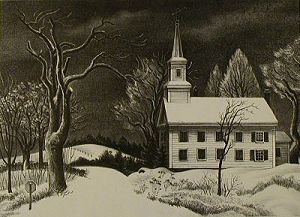
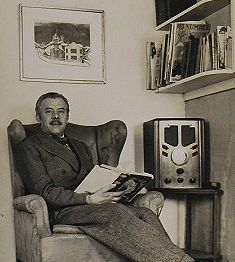
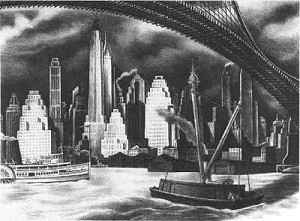

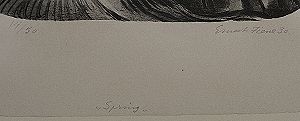
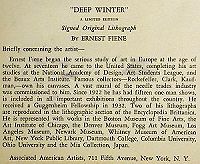
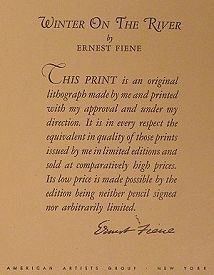
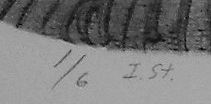

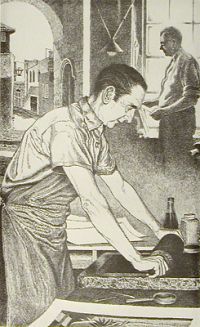 tudios during the Twenties and Thirties. In 1934, Miller also became the printer for the editions of
tudios during the Twenties and Thirties. In 1934, Miller also became the printer for the editions of 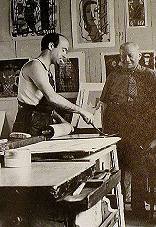 Edmond Desjobert looking on as a printer
Edmond Desjobert looking on as a printer




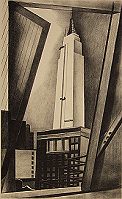
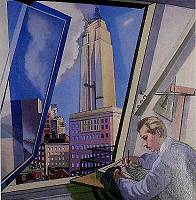
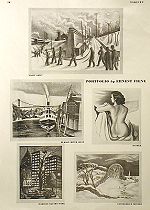 information about reproductions of specific Fiene prints in art or other publications becomes available, it is included in the notes section of the pertinent entry under the heading: "Reproduced in." This is by no means intended to be a complete list of reproductions of Fiene prints; it is more representative than exhaustive. When a reference in this section is highlighted as a link, clicking it will open the bibilography page where a fuller citation is offered.
information about reproductions of specific Fiene prints in art or other publications becomes available, it is included in the notes section of the pertinent entry under the heading: "Reproduced in." This is by no means intended to be a complete list of reproductions of Fiene prints; it is more representative than exhaustive. When a reference in this section is highlighted as a link, clicking it will open the bibilography page where a fuller citation is offered.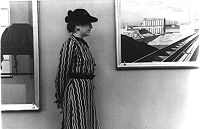 Berthe Kroll Goldsmith as Our Gallery, specialized in contemporary American art and American folk art. The name changed to Downtown Gallery in 1927. In 1935, Halpert became sole proprietor of the business, which she operated until her death in 1970. (
Berthe Kroll Goldsmith as Our Gallery, specialized in contemporary American art and American folk art. The name changed to Downtown Gallery in 1927. In 1935, Halpert became sole proprietor of the business, which she operated until her death in 1970. (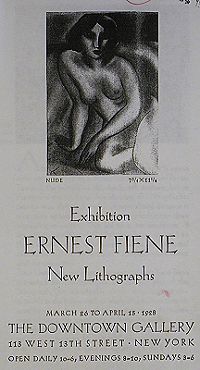 which ran from March 26 through April 15, 1928. The catalogue included
which ran from March 26 through April 15, 1928. The catalogue included 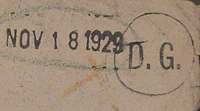

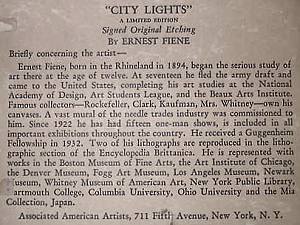
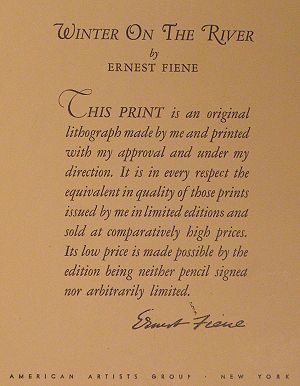 White for the etchings, and the Spiral Press for the woodcuts. The prints were featured in many of the leading print exhibitions and publications of the period.
White for the etchings, and the Spiral Press for the woodcuts. The prints were featured in many of the leading print exhibitions and publications of the period.